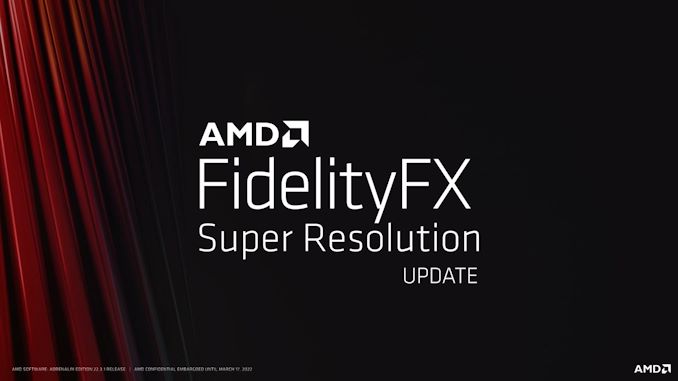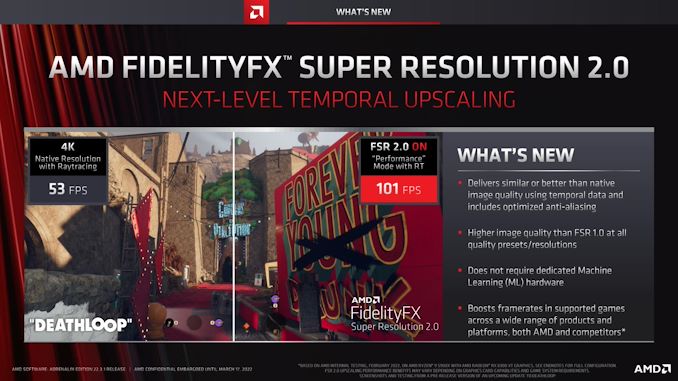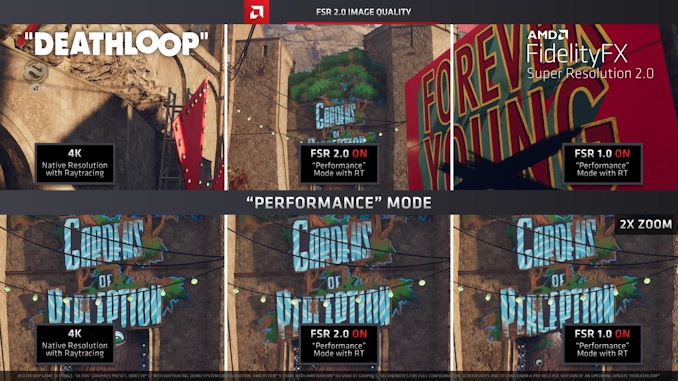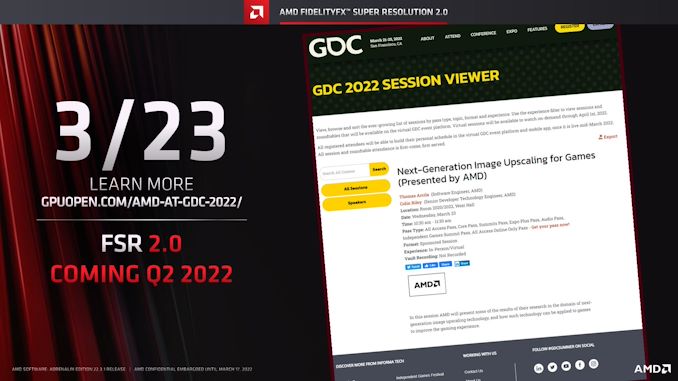AMD Teases FSR 2.0: Temporal Upscaling Tech for Games Coming in Q2
by Ryan Smith on March 17, 2022 9:01 AM EST
Alongside their spring driver update, AMD this morning is also unveiling the first nugget of information about the next generation of their FidelityFX Super Resolution (FSR) technology. Dubbed FSR 2.0, the next generation of AMD’s upscaling technology will be taking the logical leap into adding temporal data, giving FSR more data to work with, and thus improving its ability to generate details. And, while AMD is being coy with details for today’s early teaser, at a high level this technology should put AMD much closer to competing with NVIDIA’s temporal-based DLSS 2.0 upscaling technology, as well as Intel’s forthcoming XeSS upscaling tech.
AMD’s current version of FSR, which is now being referred to as FSR 1.0, was released last summer by the company. Implemented as a compute shader, FSR 1.0 was a (relatively) simple spatial upscaler, which could only use data from the current frame for generating a higher resolution frame. Spatial upscaling’s simplicity is great for compatibility (see: today’s RSR announcement) but it’s limited by the data it has access to, allowing for more advanced multi-frame techniques to generate more detailed images. For that reason, AMD has been very careful with their image quality claims for FSR 1.0, treating it more like a supplement to other upscaling methods than a rival to NVIDIA’s class-leading DLSS 2.0.
However it’s been clear from the start that if AMD wanted to truly go toe-to-toe with NVIDIA’s upscaling technology that they’d need to develop their own temporal-base upscaling tech, and that’s exactly what AMD is doing. Set to launch in Q2 (Computex, anyone?), AMD is developing and will be releasing a new generation of FSR that incorporates both spatial and temporal data for more detailed images.
Given that FSR 2.0 is an AMD technology, the company isn’t really beating around the bush here as to why they’re doing it: using temporal data allows for higher quality images. And while it goes beyond the scope of today’s teaser from AMD, like DLSS (and XeSS), they are clearly going to be relying on motion vectors as the heart of their temporal data. This means that, like DLSS/XeSS, developers will need to build FSR 2.0 into their engines in order to provide FSR with the necessary motion vector data. Which is a notable trade-off from the free-wheeling FSR 1.0, but is none the less a good trade-off to make if it can produce better upscaled images.
And although FSR 2.0 won’t launch for a few months, AMD is already taking some efforts to underscore how it will be different from DLSS 2.0. In particular, AMD’s technique does not require machine learning hardware (e.g tensor/matrix cores) on the rendering GPU. Which is especially important for AMD, since they don’t have that kind of hardware on RDNA 2 GPUs. As a result, conceptually, FSR 2.0 can be used on a much wider array of hardware, including older AMD GPUs and rival GPUs, a sharp departure from DLSS 2.0’s NVIDIA-only compatibility.
Though even if AMD doesn’t require dedicated ML hardware in client GPUs, this doesn’t mean they aren’t using ML as part of the upscaling process. To be sure, as temporal AA/upscaling has been the subject of research in games for over a decade now, there are multiple temporal-style methods that don’t rely on ML. At the same time, however, the image quality benefits of using a neural network have proven to be significant, which is why both DLSS and XeSS incorporate neural networks. So at this point I would be more surprised if AMD didn’t use one.
If AMD is using a neural network, then at a high level this sounds quite similar to Intel’s universal version of XeSS, which runs inference on a neural net as a pixel shader, making heavy use of the DP4a instruction to get the necessary performance. These days DP4a support is found in the past few generations of discrete GPUs, making its presence near-ubiquitous. And while DP4a doesn’t offer the kind of performance that dedicated ML hardware does – or the same range of precisions, for that matter – it’s a faster way to do math that’s still good enough to enable temporal upscaling and improve on FSR 1.0’s image quality.
Update: According to a report from Computerbase.de, AMD has confirmed to the news site that they are not using any kind of neural network. So it seems AMD is indeed going with a purely non-ML (and DP4a-free) temporal upscaling implementation. Color me surprised.
As for licensing, AMD is also confimring today that FSR 2.0 will be released as an open source project on their GPUOpen portal, similiar to how FSR 1.0 was released last year. So developers will have full access to the source code for the image upscaling technology, to implement and modify as they see fit.
Finally, as part of AMD’s teaser the company has released a set of PNG screenshots of Deathloop rendered with both FSR 1.0 and an early version of FSR 2.0. Though early screenshots should always be taken with a grain of salt – they’ve been cherry-picked for a reason – the difference between FSR 1.0 and FSR 2.0 in performance mode is easy enough to pick up on.
Meanwhile the difference versus native is less clear (which is the idea), though it should be noted that even native 4K is already running temporal AA here.
Native (4K) vs. FSR 2.0
Ultimately, today’s announcement is a teaser for more information to come. At next week’s GDC, AMD will be hosting a session on the 23rd called “Next-Generation Image Upscaling for Games”, where AMD will be presenting their research into image upscaling in a developer-oriented context. According to AMD we should expect a little more technical information from that session, while the full details of the technology will be something AMD holds on to until closer to its launch.
If all goes according to plan, FSR 2.0 will launch next quarter.




















46 Comments
View All Comments
Spunjji - Monday, March 21, 2022 - link
V1 was/is pretty decent at high resolutions and quality modes, which is useful for some classes of GPU. Sadly it's lacking at 1080p where it's arguably most needed. It does also have the advantage of being able to be applied globally, though, like on Steam Deck or with RSR.Oxford Guy - Thursday, March 17, 2022 - link
Good thing AMD dropped driver support for Fiji in July and gives us the downgrade of the PCI-e 4x 6500 XT as the obviously superior option to having things like working fan control in Windows 10.vlad42 - Friday, March 18, 2022 - link
AMD moved the 7 year old Fiji GPUs to the legacy driver stack. That means they will still get updates on an as needed basis. The GCN gen 3 architecture, first released in 2014, that Fiji was based on, has not been sold or particularly relevant in a long time (it might still be in the embedded space, but that is a completely different situation). The last time GCN gen 3 was used in a consumer product was with Bristol Ridge & Stony Ridge APUs in 2016!The 6500XT is a perfectly fine for modern PCIe 4.0 enabled systems without integrated graphics that need a cheap GPU for basic office work, web browsing, coding, light gaming (think easy to run indie games and older games), etc. While I would like the price to be lower, with the current market that just is not viable.
Oxford Guy - Monday, March 21, 2022 - link
'The 6500XT is a perfectly fine for modern PCIe 4.0 enabled systems''Modern' is the equivalent of 'natural' on food labels.
'That means they will still get updates on an as-needed basis.'
What it actually means is that AMD won't bother to update the drivers when updates are needed. Fan control is already broken in Windows 10 and some game-breaking incompatibilities have been known for quite some time. Windows 11 also hit the market shortly after AMD dropped Fiji support.
Bottom line is that AMD prematurely discontinued driver support for Fiji and none of the excuses wash.
Oxford Guy - Monday, March 21, 2022 - link
'Modern' PCI-e 4x!'Modern' 4 GB of VRAM!
Many 'modern' excuses to go with this, given the discontinuation of Fiji driver support in the midst of history's worst GPU shortage.
Oxford Guy - Monday, March 21, 2022 - link
Fiji GPUs were being sold in 2017 and AMD dropped Fiji driver support halfway through 2021.Pathetically short support period, especially in history's worst GPU shortage + the high cost of Fiji cards + releasing an inferior product in 2022 + dropping driver support shortly before Windows 11.
Just pathetic, including the unwillingness to hold AMD accountable.
Spunjji - Monday, March 21, 2022 - link
I don't know why you insist on comparing Fiji to the 6500 XT. It's a deeply silly comparison.What is "holding AMD accountable" meant to be? Fuming in a comment section? Come off it. You just thrashed and hissed at someone making the valid point that the 6500 XT is a flawed product that nonetheless has a place in the current absurd GPU market. You're not here to hold anyone accountable, you're just having a rant.
Oxford Guy - Wednesday, March 23, 2022 - link
‘It's a deeply silly comparison.’Stopped reading there. No point in going further when the post is clearly illogical.
mode_13h - Monday, March 28, 2022 - link
Ooh. Certainly seems like *someone* doesn't like being held to account!Abort-Retry-Fail - Saturday, April 23, 2022 - link
Oxie Strikes Again (rolling eyes)
I got a TR Pro workstation with a 'Fiji ' dual-BIOS Sapphire R9 Fury Tri-X OC, purchased new for $250 years ago. I am running "Radeon Pro Software for Enterprise" doing 'content creation' primary in Sony Vegas 18. I replaced the original GPU (Quadro P2200 5GB) as it cannot keep up in general compute with that 'ancient' Pirate Islands Franken-Card.
It says more about you when you always dump on AMD ... just sayin. ...